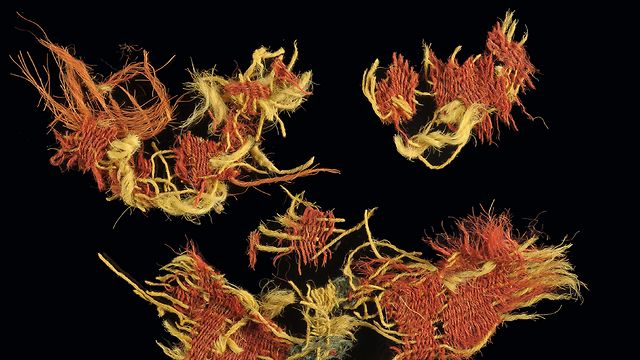
Microscopic image of woolen textile from Timna dyed in red and blue stripes
Photo: Israel Antiquities Authority
The mystery of King Solomon’s mines has yet to be solved, but researchers have found dyestuff used to dye textiles in the area of the Timna copper mines, some 30 kilometers north of Eilat. The mines, once attributed to the wisest of men, are now believed to have been run by the Israelites’ antagonist, the Edomites.

Excavations, conducted since 2013 in the Timna Valley and directed by Dr. Erez Ben-Yosef of Tel Aviv University, have recovered dozens of 3,000-year-old textile fragments that were preserved thanks to the region’s extreme arid climatic conditions. The textiles date to King Solomon’s reign, in the Iron Age (11-10th centuries BCE), and some are decorated with a pattern of red-and-blue bands.
The find is the earliest evidence of use of a plant-based dye in Israel and the Eastern Mediterranean. According to the researchers the metalworkers were probably entitled to wear colorful clothing as a mark of their high status.
The study, led by Dr. Naama Sukenik of the Israel Antiquities Authority and Dr. Erez Ben-Yosef of Tel Aviv University, in cooperation with a research team from Bar-Ilan University, was published Wednesday in the journal PLOS ONE.

Microscopic magnification (x60) of woolen textile from Timna dyed in red and blue stripes (Photo: Israel Antiquities Authority)
Analysis of the dyes showed the use of two main plants: Madder, whose roots provided a red dye, and woad, used to produce indigotin, a blue dye created in a long and complex process involving reduction and oxidization that lasted a number of days. Both these plants are among the best-known plant dyes in the ancient world and were in use until the advent of synthetic dyes.
Timna, where the dyes were discovered was an important smelting and mining site for the production of copper.
According to Ben-Yosef and Dr. Naama Sukenik of the Israel Antiquities Authority, the findings “indicate that the society at Timna, identified with the Kingdom of Edom, was hierarchical and included an upper class that had access to colorful, prestigious textiles.”
Ben-Yosef and Sukenik explain that the context in which the textiles were found suggests that metalworkers responsible for operating the smelting furnaces were members of that upper class, enjoyed high social status and wore distinctively colored garments thanks to the considerable skill required to master the process of turning stone into copper.
“In this sense, the findings are a real innovation, since they contradict the previous research supposition that the furnaces in the heart of the desert were operated by slaves,” Ben-Yosef and Sukenik said.
















